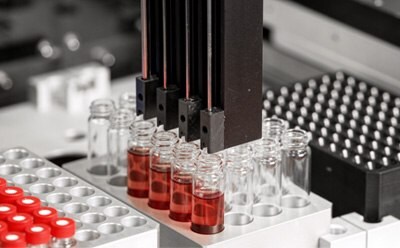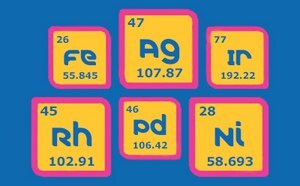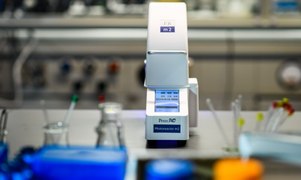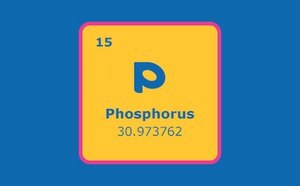Reaction Design & Optimization

Testing on April 23, 2025
Chemical reaction design and optimization is vital in organic synthesis research. By altering the reaction parameters (catalyst, pH, solvent, temperature, or time), certain outputs (cost savings, purity, selectivity, or yield) can be achieved. In optimizing chemical reactions, flexibility, precision and reproducibility are required of the synthesis tools with which the experiments are carried out. In designing chemical reactions, focus is placed on building a synthetic pathway to a target molecule from commercially available starting materials.
A “disconnected approach” is typically taken, where focus is placed on the construction of key bonds. The process is broken down into simple steps, working backwards from the target molecule rather than forwards from the starting material. While many chemists resort to their extensive reaction knowledge to make these synthetic routes, there are now many software tools, such as SYNTHIA™, which allow users to easily analyze custom pathways for known and novel molecules against search criteria.
Featured Categories
Buchwald Catalysts and Ligands enable versatile cross-coupling reactions for C-C, C-N, and other bond formations.
Buchwald Catalysts and Ligands enable versatile cross-coupling reactions for C-C, C-N, and other bond formations.
Photocatalysis utilizes visible light to activate a chemical reaction. Our extensive portfolio of catalysts and photoreactors enable consistent reactions in photoredox catalysis.
Explore a wide array of phosphine ligands for cross-coupling reactions and diverse applications.
Several experimental methodologies can be employed in reaction optimization. In a trial and error, or one variable at a time, approach, all experimental inputs are kept constant, except one, to record a certain output. A series of reactions are performed until an optimum is determined. Another variable is then chosen, and the process repeats itself until all inputs have been probed and a set of optimal inputs have been established.
A multi-parameter, or “design of experiments”, approach varies factors simultaneously from their lowest to highest value to find optimal conditions more efficiently. The different combinations are executed in the same set of experiments. Additional experiments are run between low and high factors to determine intrinsic variability. The values can be represented in a cube to illustrate the relations between the factors and the responses. For this optimization process to be successful, attention must be paid to reproducibility by performing the reactions in a systematic manner and controlled framework.
After a viable synthetic pathway to synthesize the target molecule is found countless additional hours are put in to optimize each chemical reaction to make the product better, faster, or more efficient. Utilizing chemical reaction design optimization can lead to scientific breakthroughs more rapidly.

Figure 1.Reaction Optimization Table
Visit our document search for data sheets, certificates and technical documentation.
Related Articles
- Sita molekularne selektywnie adsorbują cząsteczki, co ma kluczowe znaczenie dla różnych procesów przemysłowych.
- We współpracy z Materia, Inc. mamy przyjemność zaoferować sześć imidazolidynonów OrganoCatalysts™.
- A wide range of NHC ligands are commonly available which exhibit high activities.
- All of the preformed catalysts used in the kit are air and moisture stable complexes in their commercially available form.
- KitAlysis High-Throughput Screening Kits provide solution to efficiently identify or optimize suitable catalytic reaction conditions. Chemist can rapidly run 24 unique micro scale reactions in parallel with tailored conditions.
- See All (164)
Related Protocols
- Właściwe techniki czyszczenia szkła laboratoryjnego mają kluczowe znaczenie dla uzyskania wysokiej jakości wyników eksperymentów i badań.
- Wszechstronne zastosowania chemii acetylenu, od syntezy organicznej po chemię bioorganiczną, wymagają wydajnych metod syntezy.
- Odczynniki SnAP ułatwiają syntezę nasyconych N-heterocykli dla różnych struktur.
- Przewodnik krok po kroku dla KitAlysis Suzuki-Miyaura Cross-Coupling Reaction Screening Kit.
- Rozszerzająca się klasa odczynników SLAP zapewnia dostęp do nasyconych N-heterocykli oraz alifatycznych aldehydów i ketonów bez dodatkowych odczynników lub generowania toksycznych produktów ubocznych.
- See All (18)
Find More Articles and Protocols
How Can We Help
In case of any questions, please submit a customer support request
or talk to our customer service team:
Email custserv@sial.com
or call +1 (800) 244-1173
Additional Support
- Chromatogram Search
Use the Chromatogram Search to identify unknown compounds in your sample.
- Kalkulatory i aplikacje
Web Toolbox - narzędzia naukowe i zasoby dla chemii analitycznej, nauk przyrodniczych, syntezy chemicznej i materiałoznawstwa.
- Customer Support Request
Obsługa klienta, w tym pomoc przy zamówieniach, produktach, kontach i kwestiach technicznych związanych z witryną.
- FAQ
Explore our Frequently Asked Questions for answers to commonly asked questions about our products and services.
Zaloguj się lub utwórz konto, aby kontynuować.
Nie masz konta użytkownika?



